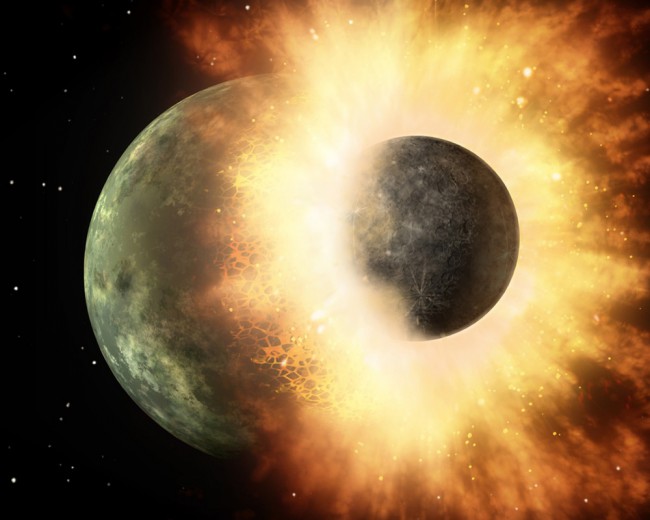An artist’s concept shows a celestial body about the size of our moon slamming at great speed into a body the size of Mercury. NASA/JPL-Caltech
Instead of core formation occurring by iron sinking down to the growing Earth’s core in large blobs, that iron was vaporized, spread out in a plume over the surface of Earth and rained out as small droplets.
By Sandia National Laboratories, Albuquerque, New Mexico | Published: Wednesday, March 18, 2015
Researchers at Sandia National Laboratories’ Z machine have helped untangle a long-standing mystery of astrophysics: Why iron is found spattered throughout Earth’s mantle, the roughly 2,000-mile-thick region between Earth’s core and its crust.
At first blush, it seemed more reasonable that iron arriving from collisions between Earth and planetesimals — ranging from several meters to hundreds of kilometers in diameter — during Earth’s late formative stages should have powered bullet-like directly to Earth’s core where so much iron already exists.
A second correlative mystery is why the Moon proportionately has much less iron in its mantle than does Earth. Since the Moon would have undergone the same extraterrestrial bombardment as its larger neighbor, what could explain the relative absence of that element in the Moon’s own mantle?
To answer these questions, scientists led by Stein Jacobsen at Harvard University and Sarah Stewart at the University of California in Davis wondered whether the accepted theoretical value of the vaporization point of iron under high pressures was correct. If vaporization occurred at lower pressures than assumed, a solid piece of iron after impact might disperse into an iron vapor that would blanket the forming Earth instead of punching through it. A resultant iron-rich rain would create the pockets of the element currently found in the mantle.
As for the Moon, the same dissolution of iron into vapor could occur, but the satellite’s weaker gravity would be unable to capture the bulk of the free-floating iron atoms, explaining the dearth of iron deposits on Earth’s nearest neighbor.
Looking for experimental rather than theoretical values, researchers turned to Sandia’s Z machine and its Fundamental Science Program coordinated by Thomas Mattsson. This led to a collaboration among Sandia, Harvard University, UC Davis, and Lawrence Livermore National Laboratory (LLNL) to determine an experimental value for the vaporization threshold of iron that would replace the theoretical value used for decades.
To read the full Astronomy magazine article, click here...

